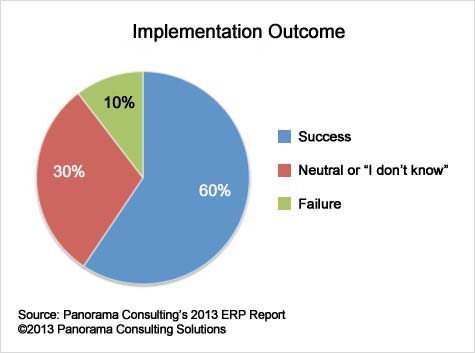ERP ‘Dichotomy’: Cost Is up, but So Is Satisfaction
According to Panorama Consulting's just released 2013 ERP Report, while most ERP installs still exceed allotted time, go over budget and do not return all of the business benefits companies expect, the vast majority of companies report high overall satisfaction with their ERP implementation.
The report found that approximately 59 percent of projects exceeded planned budgets, and 53 percent of projects exceeded planned durations. Also, 56 percent of respondent organizations received less than 50 percent of the measurable benefits they anticipated from their ERP software initiatives.
“For the most part the trends were fairly consistent in some of the key metrics that we look at as far as implementation costs, duration and benefits realized,” says Panorama founder Eric Kimberling.
ERP Costs and Benefits
Two metrics did see notable increases, Kimberling says. Panorama found ERP implementations now take longer, rising from an average of 16 months to 18 months. And the percentage of companies that cited a failure to realize at least half of the expected benefits from ERP grew from 48 to 56 percent.

Kimberling attributes lengthier ERP projects to companies under-investing in key implementation activities because of the recession. Many of the projects that companies report recently finishing were started during the recession, he says. Longer projects tend to cost more.
“On the cost side of the equation, the average raw dollars spent on total ERP implementation dropped last year … but if you look at it as a percentage of revenue the number actually went up,” Kimberling says.
The average install cost, as a percentage of revenue, increased from 5 to 5.5 percent this year compared to past years.
Yet satisfaction levels rose five percentage points, going from 81 percent in 2011 to 86 percent in 2012.
“So that's a little mixed,” says Kimberling. “The fact that there is this dichotomy … Satisfaction levels are still fairly high so it tells us that companies aren't clearly defining what success means … that there's a difference between well-functioning software and software that is functioning versus a successful implementation.”
In essence, Kimberling says, companies may be expressing satisfaction with the software itself, which functions as advertised, and not the business benefits they have received from ERP.
Another interesting trend highlighted in the report is the rise of cloud and software-as-a-service (SaaS) ERP. Customers continue to increase their utilization of these technologies, with 26 percent of ERP implementations leveraging some sort of cloud or SaaS solution, compared to 16 percent last year.
ERP Advice
For anyone considering an ERP project, Kimberling offers these recommendations:
Do Your Homework. Most problems come from rushing a project and not doing enough pre-implementation planning. Planning involves lots of hard work and companies, like people, often skip the hard stuff in favor of getting to the promised benefits of their post-ERP environment.
Get Executive Sponsorship. ERP starts at the top, so it’s a given that most of your executives are on board. For a successful project, it's necessary to keep them involved — especially when critical decisions must be made around business process re-engineering and applying appropriate resources and money to complete the project.
Watch for Project Fatigue. If you don't assign the resources you need to get the project done right, your team will get burned out. This will lead to delays, which will likely lead to cost over-runs. Like having a good plan, don't skimp on this step. Hire the folks you need — like a project manager with ERP experience — if you don't have them in-house.
Don't Upgrade in the Middle. Somewhat surprisingly, many companies insist on upgrading their software in the middle of an implementation. This can be disastrous. Install what you've bought first and upgrade later. Sweat the small stuff, like how reports look, after the install. Constantly trying to meet minor demands so people don’t have to change the way they do things will likely lead to over-runs.
Understand ERP is a Business Initiative. ERP is about business transformation, not technology implementation. Many companies fail to realize this and delegate too much of the important decision-making to project managers and engineers tasked with handling the implementation at the tactical level. Important decisions, like how a business process will be reorganized or how departments will change or be eliminated, should be made in the C-suite.
“It is about the business and not the technology,” says Kimberling. “That's where the successful companies out-perform the troubled implementations; that's where they separate themselves, is on business process design and reengineering. They focus on the organizational change aspects of the implementation rather than myopically focusing on just configuring the software, testing it and slamming it in for the implementation.”
Study Methodology
Panorama's report looks at the results of ERP implementations across the globe. Since beginning the annual study in 2006, Panorama has surveyed more than 2,000 implementations worldwide in an effort to quantify the problems CIOs and project teams experience when implementing new ERP systems. Polling for the 2013 ERP Report was conducted on Panorama’s website between September 2012 and January 2013, and 172 respondents completed the survey.
Now a freelance writer, in a former, not-too-distant life Allen Bernard was the managing editor of CIOUpdate.com and other technology websites aimed at helping technology pros understand an industry that has, perhaps more than any other in history, changed almost every aspect of business and life. Allen has written, assigned and edited thousands of articles that focus on the management of IT and its relationship with the business. Follow him on Twitter at @allen_bernard1, on Google+ or on Linked In.
